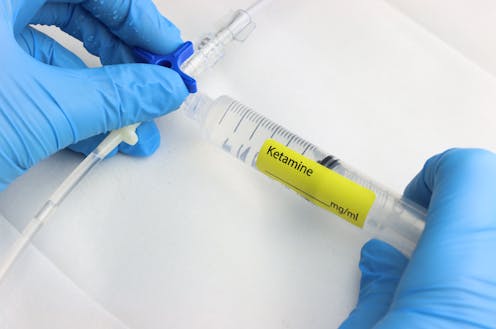Ketamine can rapidly reduce symptoms of PTSD and depression, new study finds
The analysis shows that ketamine may start relieving symptoms of PTSD within one day, but it is still unclear how long the effects last and how many injections are needed to maintain benefits.

The drug ketamine can reduce the symptoms of post-traumatic stress disorder, or PTSD, and symptoms of depression in patients as early as a day after injection. That is the key finding of my team’s new meta-analysis, just published in the journal Annals of Pharmacotherapy.
Ketamine is an anesthetic that is sometimes used as a substance of abuse but is increasingly being explored as a treatment for a range of mental health conditions.
We analyzed six randomized controlled trials representing 259 patients with moderate to severe PTSD. In all trials, about half were injected with ketamine. The rest received either salt water or the drug midazolam, a benzodiazepine like Xanax that is also used as an anesthetic agent.
Patients receiving ketamine saw their PTSD symptoms reduced by about 25% both at one day and one week after therapy. But if patients received repeated injections over four weeks, PTSD symptoms declined by only 12%. Reduction of depression symptoms were more modest but still significant.
In most of these trials, patients only received a single shot; in the other two, they were given an injection at the same dose six or more times over two to four weeks. The benefits after the first injection were similar across studies, but it’s unclear how well additional doses of ketamine over time maintain these benefits.
Overall, the benefits of even a single ketamine injection occur rapidly, but are modest in magnitude. The best regimen to maintain these benefits by reinjecting ketamine has not been determined.
Why it matters
PTSD, a debilitating mental health disorder, occurs when past trauma causes flashbacks, nightmares, depressed mood, anxiety and avoidance of activities that could trigger traumatic memories. Patients with PTSD are twice as likely to attempt suicide than the general population.
About 13 million Americans have PTSD in a given year, which translates to nearly 5% of the adult population. PTSD is caused by experiencing or witnessing a traumatic event. Many combat veterans have the disorder, as do survivors of physical assault, natural disasters, child abuse and sexual abuse. Those with moderate to severe disease cases lose an average of about three and a half days of work per month due to triggered symptoms or treatment for the illness.
Trauma-focused psychotherapy – techniques that help patients recall, process and respond to traumatic memories – is the treatment of choice for PTSD, but it can take several weeks to see benefits, and not all patients respond.
For these people, antidepressants such as paroxetine, sertraline and venlafaxine are recommended as alternatives, or as an addition to psychotherapy.
But like psychotherapy, these drugs may not work for a while – about five to eight weeks – unlike ketamine, which seems to begin working almost immediately. That said, the reduction in PTSD and depression symptoms over time following ketamine injection is about the same as what the traditional antidepressants provide once they take effect.
Because some people with severe PTSD may be experiencing suicidal thoughts, time is of the essence; they simply might not be able to wait for traditional options to begin working. Ketamine might be an effective bridge to immediately reduce patients’ symptoms until trauma-focused psychotherapy and other antidepressants can kick in.
What still isn’t known
The big unknown with using ketamine for PTSD and depressive symptoms is how often the injections are needed. The data simply is not robust enough to determine whether multiple doses maintain the effects better than simply using a single dose.
Ketamine costs around US$800 per injection, so knowing how much to administer each treatment and how many injections to give over time is important.
Importantly, ketamine can be abused. If purchased from unlicensed pharmacies or online stores, the ketamine product is not approved by the Food and Drug Administration. It may not have the correct dose, may have expired or might not even have any ketamine in it. Or, it may contain a substitute drug with a dangerous active ingredient, like the synthetic street drug LSD. Such fake products can harm or even kill patients
The Research Brief is a short take on interesting academic work.
C. Michael White does not work for, consult, own shares in or receive funding from any company or organization that would benefit from this article, and has disclosed no relevant affiliations beyond their academic appointment.
Read These Next
Congress takes up health care again − and impatient voters shouldn’t hold their breath for a cure
Why does health care reform keep failing despite decades of attention and expanding costs? A scholar…
Risks young chimps take as they swing through the trees underscore role of protective parenting in h
The youngest chimpanzees are the biggest risk-takers. Would humans show the same pattern if adults weren’t…
Today Venezuela, tomorrow Iran: can the Islamic Republic survive a second Trump presidency?
Perhaps no one outside of Venezuela should care more about the US invasion and capture of President…






